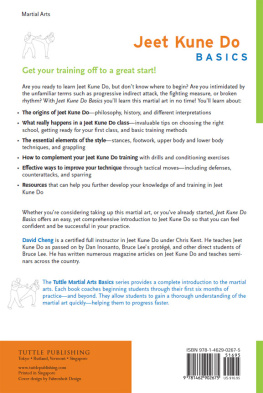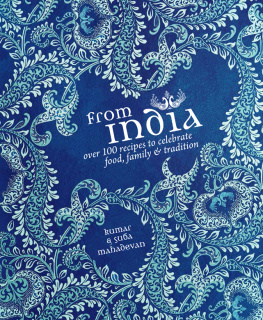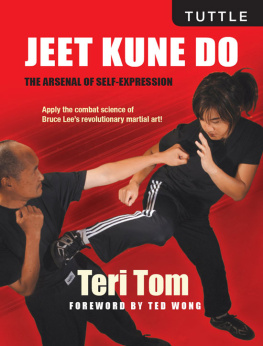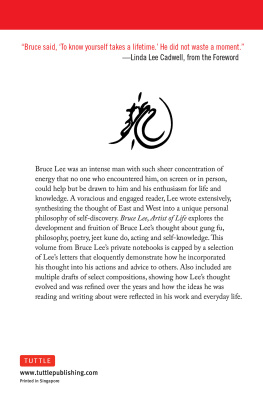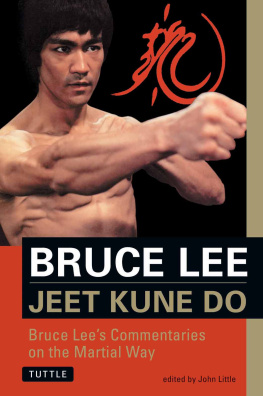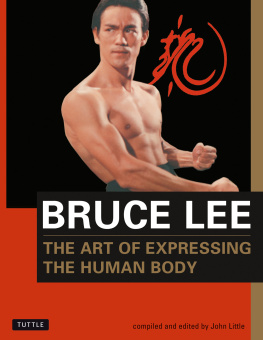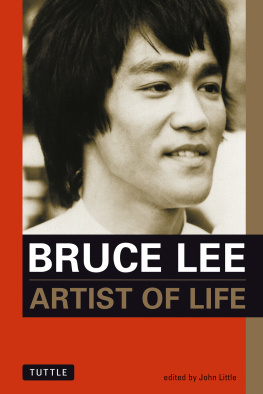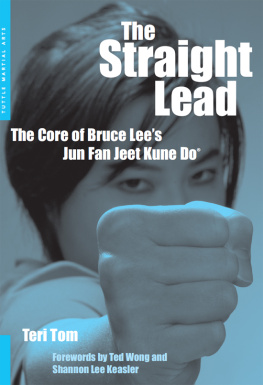jeet kune do basics

TUTTLE PUBLISHING
Tokyo Rutland,Vermont Singapore
Please note that the author and publisher of this book are NOT RESPONSIBLE in any manner whatsoever for any injury that may result from practicing the techniques and/or following the instructions given within. Since the physical activities described herein may be too strenuous in nature for some readers to engage in safely, it is essential that a physician be consulted prior to training.
Published by Tuttle Publishing, an imprint of Periplus Editions (HK) Ltd., with editorial offices at 364 Innovation Drive, North Clarendon, Vermont 05759 U.S.A.
Copyright 2004 Periplus Editions (HK) Ltd.
All rights reserved. No part of this publication may be reproduced or utilized in any form or by any means, electronic or mechanical, including photocopying, recording, or by any information storage and retrieval system, without prior written permission from the publisher.
Grateful acknowledgement is made for permission to reprint excerpts from the following copyrighted work: Jeet Kune Do: Bruce Lees Commentaries on the Martial Way by Bruce Lee and John Little. Copyright 1997 by Linda Lee Caldwell. Reprinted with permission of Charles E. Tuttle Co. Inc.
Library of Congress Cataloging-in-Publication Data
Cheng, David, 1959
Jeet Kune Do basics / David Cheng.1st ed.
191 p. : ill.; 25 cm
Includes bibliographical references.
ISBN 978-1-4629-0267-5
1. Jeet Kune Do. I. Title. GV1114.6.C537 2003
796.815--dc22
2003027961
Distributed by
North America, Latin
America & Europe
364 Innovation Drive
North Clarendon,
VT 05759-9436
Tel 1 (802) 773 8930
Fax 1 (802) 773 6993
info@tuttlepublishing.com
www.tuttlepublishing.com | Asia Pacific
61 Tai Seng Avenue, #02-12
Singapore 534167
Tel: (65) 6280 1330
Fax: (65) 6280 6290
Email: inquiries@periplus.com.sg
Web site: www.periplus.com |
Japan
Tuttle Publishing
Yaekari Building, 3rd Floor
5-4-12 Osaki
Shinagawa-ku
Tokyo 141 0032
Tel: (81) 3 5437-0171
Fax: (81) 3 5437-0755
tuttle-sales@gol.com
First edition
12 11 10 09 10 9 8 7 6 5 4
Printed in Singapore
TUTTLE PUBLISHING is a registered trademark of Tuttle Publishing, a division of Periplus Editions (HK) Ltd
DEDICATION
This book is dedicated first, to God the Father, the Lord Jesus Christ, and the Holy Spirit, who together are the source of inspiration and guidance in my life.
And second, to my wife, Vera, and my children, Lauren and Jonathan, who have supported me and been patient with me as I worked on the book. Much love to you all.
acknowledgments
I WOULD LIKE TO THANK Chris Kent, my teacher, mentor, and friend, for his invaluable instruction in the art of Jeet Kune Do over the years and for opening my eyes to my potential, using Bruce Lees art as a vehicle.
I would also like to express my thanks to various original students of Bruce Lee who have illuminated my understanding of Jeet Kune Do, namely, Bob Bremer, Richard Bustillo, Dan Inosanto, Pete Jacobs, Taky Kimura, Daniel Lee, Jerry Poteet, Patrick Strong, and Ted Wong. Thanks to second-generation instructors Cass Magda, Tim Tackett, and Dan Sullivan, who have also helped me in my journey.
Thanks also to Jeff Scharlinmy good friend, training partner, Jeet Kune Do brother, and a solid teacher in his own rightfor his friendship, suggestions, and assistance in this project. His feedback and criticisms were very helpful.
I would also like to thank Jaimee Itagaki, photographer extraordinaire, for her keen eye and invaluable suggestions in taking the pictures for this book. Her professionalism and easy-going personality helped make the work so enjoyable.

Much appreciation goes to my students who assisted in the photographs for the book, namely, Andrew Kim, Luca Levorato, Jeff Ng, Moamer Qazafi, and Stanley Quon. Thanks also to my other students, who have contributed to my own growth. They are all helping to keep the Jeet Kune Do legacy alive.
part 1
introduction
T HERE IS A JOKE that says, If you ask ten different Jeet Kune Do instructors what Jeet Kune Do is, you will get ten different answers. Another joke in the same vein asks, How many Jeet Kune Do instructors does it take to screw in a light bulb? Answer: Fiveone to screw in the light bulb, and four to tell him that hes doing it wrong.
What these bits of humor tell us is that there is wide disagreement about the nature of Jeet Kune Do. Some believe that it is basically a system with certain techniques and principles. Others think it is a philosophy, an approach to martial arts that helps each person develop his or her own style of fighting. As with many things, each interpretation has some truth to it.

However, to truly understand Jeet Kune Do, we must examine its roots; we must observe where it has been, as well as where it is today. In these beginning chapters, we will look at how Jeet Kune Do originated and developed. To assist us in our understanding, we will also examine the basic principles that constitute the framework of the art. Finally, we will consider the state of Jeet Kune Do today, in terms of some of the most prominent interpretations. Having this background will give us a good start in appreciating the different elements that make up Jeet Kune Do.
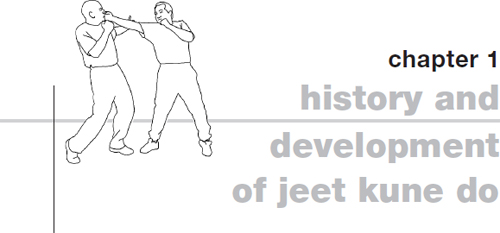
A LTHOUGH JEET KUNE DO is a young martial art, it generates more interest than many of its older counterparts. This is due, in large part, to the enigmatic life of its founder, Bruce Lee. We can safely say that Lee is so intertwined with the art that one cannot think of Jeet Kune Do without thinking of Bruce Lee. Therefore, to understand the history and development of Jeet Kune Do, we must examine the evolution of Lee himself as a martial artist.
Lee was born on November 27, 1940, in San Francisco, California. The following year, his family moved to the cramped, tropical environment of Hong Kong where he spent his childhood and teenage years growing up. Early on, Lee was exposed to taijiquan, an art practiced by his father. He also studied a little bit of Hung Gar, a southern style of gung fu (or kungfu). However, his primary formal gung fu training did not begin until his early teens, when he began learning Wing Chun, a close-quarters fighting style that emphasizes hand-trapping techniques. He studied for several years under the supervision of Yip Man, the head instructor of Wing Chun at his school.
Lee was obsessed with Wing Chun and practiced frequently. While other students were content to learn the art as a sport, Lee was interested in learning how to fight. He and other students engaged in several sparring matches with people from outside the school, quickly gaining a formidable reputation. This emphasis on practical, street-oriented testing would later play a major role in the creation of Jeet Kune Do.
During this time, Lee examined other gung fu styles. He also practiced dancing and became the cha-cha champion of Hong Kong. The knowledge that he gained from these experiences served as a reservoir of material when he developed his approach to martial arts.
Next page
